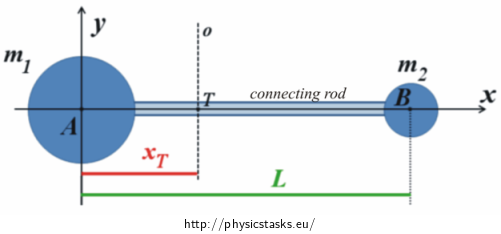The Moment of Inertia of Two Balls
Task number: 1160
Two small homogeneous balls with mass m1 and m2 are connected by a rod of length L with negligible mass. Find the moment of inertia Io of the system about the axis o which is perpendicular to the rod and passes through the centre of gravity.
Notation
m1 Mass of the first ball m2 Mass of the second ball L The length of the connecting rod I0 = ? The moment of inertia of the system about the axis passing through the centre of gravity Hint 1
Draw the situation at the beginning and position the appropriate coordinate system. Write the corresponding coordinates of both balls into the figure. Thanks to the fact that their sizes were not defined, we can consider both of the balls to be mass points with masses centralized in the centres of gravity of the original balls.
Hint 2
To find the moment of inertia Io of the system about the axis passing through the centre of gravity, we must find the first coordinate of the centre of gravity CG of the system. What is the relation for the position vector of the centre of gravity of a system of mass points?
Is it possible to determine one component of the centre of gravity at once without any calculation?
Hint 3
Determine the distance of the individual balls (mass points A and B) from the center of gravity of the system. Are we able to determine the unknown moment of inertia using their positions? Determine the moment of inertia.
Complete solution
Thanks to the fact that their sizes were not defined, we can consider both of the balls to be mass points with masses centralized in the centres gravity of the original balls.
The figure shows our situation placed appropriately into the coordinates system. Both balls lie on the x-axis; one of them is located directly in the origin of the coordinate system.

Coordinates of mass points A and B (which substitute the balls) in our case are:
\[A\,=\,[0{,}0]\] \[B\,=\,[L,0]\]First we have to determine the position of the centre of gravity, because we need to find the moment of inertia about the axis passing through the centre of gravity. The relation (for the position of the centre of gravity of n mass points) appears as follows \[\vec{r}_\mathrm{T}\,=\,\frac{\sum_{i=1}^n{m_i\vec{r}_i}}{\sum_{i=1}^n{m_i}}\] where mi are individual masses of mass points and ri are their corresponding position vectors. Based on the fact that the coordinates of the centre of gravity can be calculated as compomnents, the x coordinate of the centre of gravity is defined:
\[x_\mathrm{T}\,=\,\frac{\sum_{i=1}^n{m_ix_i}}{\sum_{i=1}^n{m_i}}\,=\,\frac{m_\mathrm{1}{\cdot}0\,+\,m_\mathrm{2}{\cdot}L}{m_\mathrm{1}\,+\,m_\mathrm{2}}\,=\,\frac{m_\mathrm{2}L}{m_\mathrm{1}\,+\,m_\mathrm{2}}\tag{1}\]The procedure mentioned above can be applied the same way for y coordinate of the centre of gravity, however, the result is obvious: the y coordinate is yT = 0 for both of the balls.
As can be seen from the figure, the distance of point A from the centre of gravity of the system is xT and the distance of point B from the centre of gravity of the system is L - xT. The distance from the centre of gravity means the distance from the axis o which is perpendicular to the rod and passes through the centre of gravity. We have everything what we need to determine the moment of inertia Io.
Do not forget that the moment of inertia of a system of n mass points about an axis is determined as follows
\[I\,=\,\sum_{i\,=\,1}^n{m_ir_i^2}\]where mi are the masses of individual mass points and ri are their distances from the given axis. In this case it is about axis o and it is given:
\[I_\mathrm{o}\,=\,m_\mathrm{1}x_\mathrm{T}^2\,+\,m_\mathrm{2}(L\,-\,x_\mathrm{T})^2\tag{2}\]We substitute for xT from equation (1) and get:
\[I_\mathrm{o}\,=\,m_\mathrm{1}(\frac{m_\mathrm{2}L}{m_\mathrm{1}\,+\,m_\mathrm{2}})^2\,+\,m_\mathrm{2}(L\,-\,\frac{m_\mathrm{2}L}{m_\mathrm{1}\,+\,m_\mathrm{2}})^2\] \[I_\mathrm{o}\,=\,\frac{m_\mathrm{1}m_\mathrm{2}^2L^2}{(m_\mathrm{1}\,+\,m_\mathrm{2})^2}\,+\,m_\mathrm{2}L^2(1\,-\,\frac{m_\mathrm{2}}{m_\mathrm{1}\,+\,m_\mathrm{2}})^2\] \[I_\mathrm{o}\,=\,\frac{m_\mathrm{1}m_\mathrm{2}^2L^2}{(m_\mathrm{1}\,+\,m_\mathrm{2})^2}\,+\,\frac{m_\mathrm{2}L^2m_\mathrm{1}^2}{(m_\mathrm{1}\,+\,m_\mathrm{2})^2}\,=\frac{m_\mathrm{1}m_\mathrm{2}L^2(m_\mathrm{1}\,+\,m_\mathrm{2})}{(m_\mathrm{1}\,+\,m_\mathrm{2})^2}\] \[I_\mathrm{o}\,=\,\frac{m_\mathrm{1}m_\mathrm{2}L^2}{m_\mathrm{1}\,+\,m_\mathrm{2}}\]Answer
The moment of inertia Io of the mentioned system about the axis o passing through the centre of its gravity is:
\[I_\mathrm{o}\,=\,\frac{m_\mathrm{1}m_\mathrm{2}L^2}{m_\mathrm{1}\,+\,m_\mathrm{2}}\]


